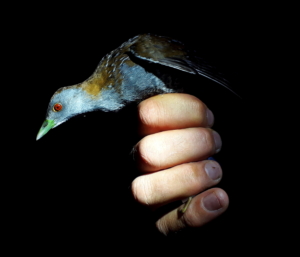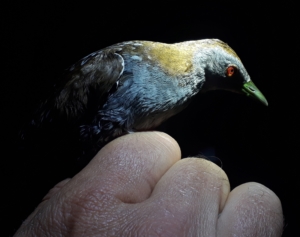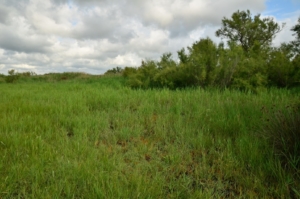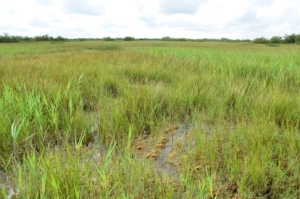
The Baillon’s Crake (Porzana pusilla) is a small bird of the rallidae family, occupying various marshes with rather low but dense vegetation. Its geographical distribution is quite wide but in France, it is a very rare nesting bird, classified as critically endangered on the IUCN Red List of Breeding Birds of France.
After the discovery of a nest on the Tour du Valat in 2003 [1] in environments very similar to those occupied in Spain, we suspected its more regular presence on the site. Surveys had been carried out to try and detect it, but the great discretion of this small bird about the size of a starling and its song, which is only heard at close range and strongly resembling those of certain green frogs, made its detection very problematic.

In the reserve’s marshes in particular, the first twilight listening sessions revealed that it was illusory to hope to hear a Baillon’s Crake among the choruses of tree frogs and green frogs, which are abundant in our marshes. Also, in 2015, a year with favourable water levels, a listening in the middle of the night, when frogs are less active, had made it possible to hear a bird sing.
Also this spring, after several bird calls recorded over Arles by Julien Birard and a bird heard on the Tour du Valat during a bittern monitoring at the beginning of the season, we therefore undertook to carry out targeted surveys in the bulrushes of the Tour du Valat, in the middle of the night. At the same time, an automatic recorder, acquired for this purpose thanks to support from the Sud-Provence-Alpes-Côte d’Azur Region, has been installed on various marshes on the site in an attempt to detect the vocal manifestations of the species more easily.
The occupied environments are almost all ponds or marshes with bulrushes Bolboschoenus maritimus with a few Reeds Phragmites australis , the water level is variable (20 to 40 cm).
 |
 |
The result is far beyond our expectations. The various surveys and recordings made it possible to detect at least 15 to 16 different birds on at least six marshes in the reserve.
Surveys were carried out between 0:00 and 4:00 a.m., walking at a slow pace through the bulrushes and actively searching the vegetation with a lamp. From time to time, an ironing was used to stimulate the birds. In addition to the vocalizations detected (singing and various calls), a few birds were observed either sneaking through the vegetation or flying away at our feet. Two birds were even captured (and released of course) by hand.
Contacts :
Damien Cohez [2] – Manager of the Regional Nature Reserve & Deputy to the Director of the Estate
Julien Birard [3]